Are single-sex services legal?

Does the judgment in AEA v EHRC (where permission for a judicial review of the EHRC Statutory Code of Practice was refused) mean that the legality of single-sex services has changed?
The answer is no.
The Equality Act still allows single-sex services in a range of common everyday and specialist situations.
The EHRC says that “trans-persons can be excluded from a service where that is justified”. But it is still advising that this must often be based on individual “case-by-case” determination.
This article sets out why we think the “case-by-case” approach is unworkable. It is accompanied by a policy briefing on single sex services. We are also developing practical guidance for service providers.
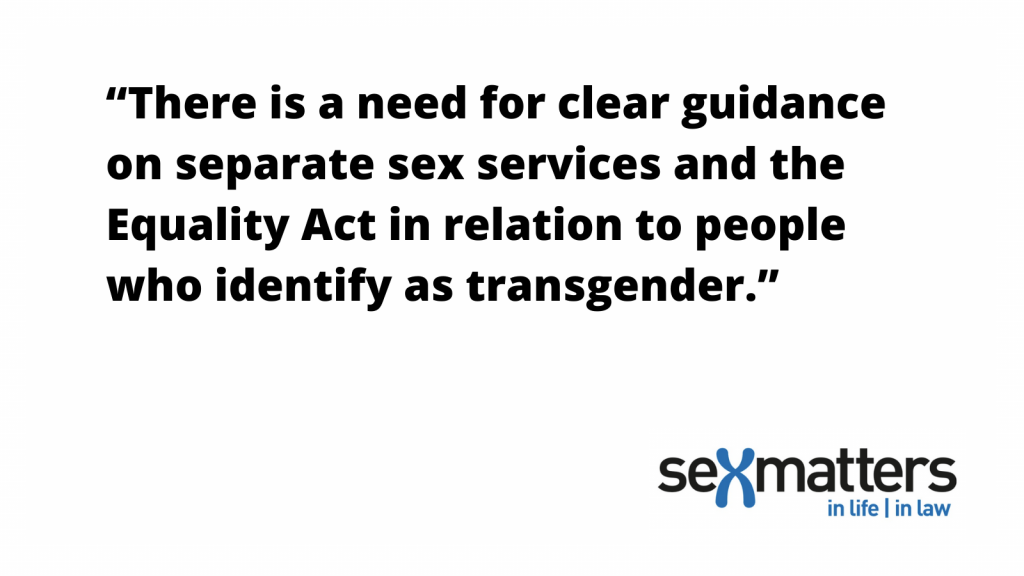
Indirect discrimination
In its defence against permission for a judicial review the EHRC said that ad hoc individualised assessments are needed to avoid indirect discrimination.
Indirect discrimination is where a “policy, criterion or practice” (PCP; i.e. a rule or a way of doing things) is applied by an organisation, and the rule places a group with a protected characteristic at a particular disadvantage. For example, a policy that all staff must wear a certain kind of hat as part of the uniform would discriminate against Sikhs. A less discriminatory rule would say that turbans should be in uniform colours as an alternative.
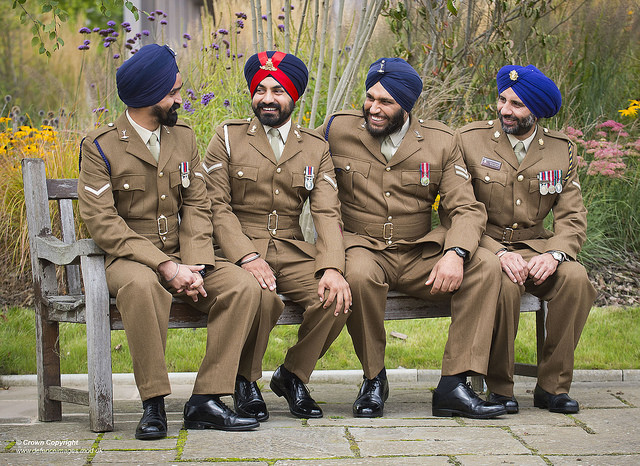
A business that always has a certain important meeting, which is part of a promotion track, late on a Friday afternoon would be discriminating against observant Jews. A less discriminatory practice would be to schedule the meeting at a time when everybody can attend.
Rules that impact differently on groups with protected characteristics cannot always be avoided. It is not unlawful indirect discrimination where the rule or policy can be shown to be a “proportionate means to a legitimate aim”. This is often called objective justification.
For example, working in a butcher’s shop requires handling pork products as part of the job. This puts people with a religious prohibition against doing so at a particular disadvantage. Whether it is a justified requirement depends on the situation. A large supermarket might be expected to accommodate staff who won’t handle unwrapped pork products, since this doesn’t have to be part of everyone’s job, whereas a small butchers shop or deli wouldn’t.
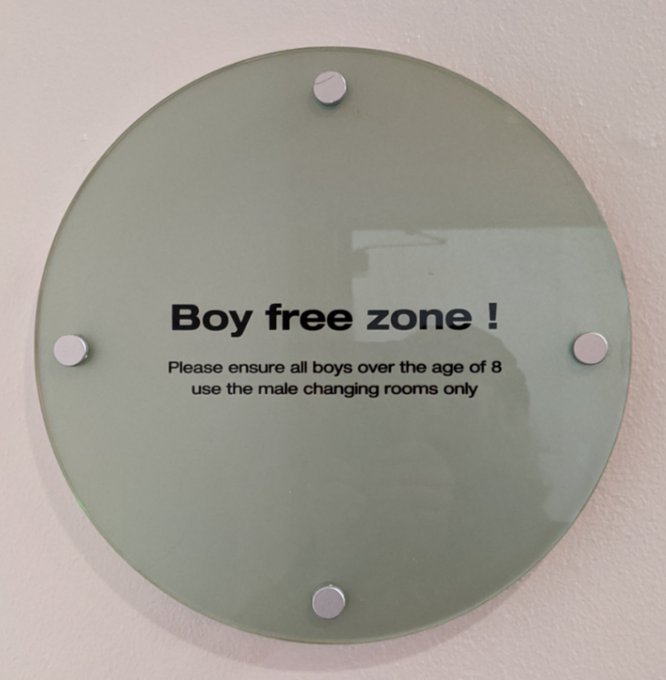
The EHRC argued that refusing to allow a male with the protected characteristic of gender reassignment (i.e. someone who is at any stage of a personal journey of gender transition) access to a woman’s facility is “almost certainly prima face indirect discrimination in relation to the protected characteristic of gender reassignment”, but that “trans-persons can be excluded from a service where that is justified”.
The judge agreed with this, and said that the circumstances in which it is legitimate to exclude a trans person from a service could not be resolved in the abstract but required consideration of specific situations.
The EHRC argues that this requires individualised case-by-case assessment of whether a particular trans person can be excluded from a service provided for the opposite sex on a particular day. It said that “ultimately, and as set out in the code of practice, it “is a question of balancing the ‘needs’ and potential ‘detriment’ of the different service-users in any particular case.”
According to the EHRC’s argument, this is how to undertake the case-by-case assessment of whether a PCP is a proportionate means to a legitimate aim:
Sex Matters thinks this is a misunderstanding of the law, and unworkable.
In applying the test of whether a PCP is a “proportionate means to a legitimate aim”, the particular case relates to the rule and its context (the business, the building etc), not to the rule and each individual person who is impacted by its enforcement on a particular day.
Two unrealistic case examples
The EHRC has been asked to develop guidance on single-sex services, in general and in relation to schools in particular, and has so far failed to do so.
Sex Matters thinks this is because its solution of individual case-by-case assessment cannot be translated into meaningful, workable guidance. And if it cannot be translated into guidance by the country’s equality regulator, then it cannot be translated into policy by corporations and public bodies. So 18-year-old gym receptionists and pub security staff are being called on to decide who can use single-sex services on an ad hoc basis without clear rules. And women’s refuges face funding pressures if they say that including male-to-female transsexuals in a female-only service is impossible, and not their job.
The individualised case-by-case approach is not fit for purpose.
The EHRC offered two case examples in its legal submissions that illustrate this.
The service station
The EHRC’s first example is of a separate-sex service (i.e. one where both men and women are catered for separately):
“The analysis is illustrated by a scenario in which a service station has separate toilets for men and women and requires people to use the toilets of their sex as legally recognised.”
EHRC Summary Grounds of Response (Paragraph 24)
This scenario is both insufficiently detailed and unrealistic. Is this a large motorway service station with two washrooms with banks of sinks, cubicles (and urinals) for each sex (in which case they would certainly also have unisex provision)? Or is it a small mom-and-pop service station with two individual toilets round the side and no other provision?
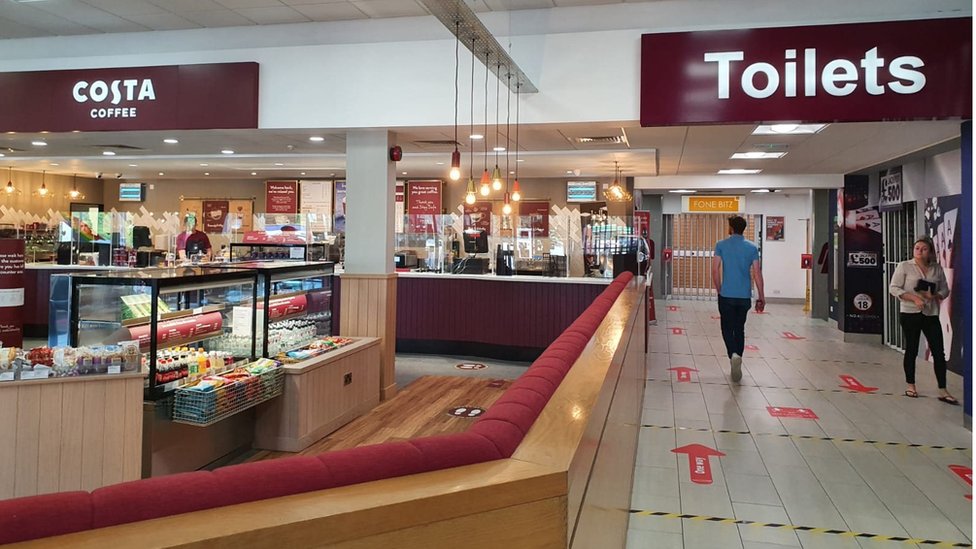

In either case, the scenario of using legal sex as the entry criterion is unrealistic. Service station staff are unlikely to be trained to understand the legal difference between a person with a gender recognition certificate and a person without one, and people do not carry their birth certificates around with them. In practice, we have found no examples of service providers using this policy.
Nevertheless, since this is the scenario that the nation’s equality body has come up with, let’s look at it. In fact, there are three separate PCPs in its scenario:
- The service station has a practice of providing only male and female toilets (there is no unisex option).
- The service station has a criterion that requires people to use the toilet of their sex.
- The service station has a policy that defines “sex” as legally recognised, not as biological (or perceived by others).
In presenting the case, the EHRC engages in a game of bait-and-switch about what the detriment is.
At first it talks about exclusion of a “transwoman” from the women’s toilets as being the detriment, but then it says “transwomen, if required to use the men’s toilets, are likely to be significantly adversely affected”, as they will find it “distressing and humiliating to be forced at a service station to use the men’s toilets”.
What PCP is the EHRC applying?
So in fact the specific PCP that the EHRC identifies as causing a detriment is the lack of a unisex facility. It is this that forces someone to use one or other of the sex-segregated facilities (or go without), despite feeling distressed and humiliated (and potentially causing distress and humiliation to others).
Certainly a policy of not having any unisex provision is detrimental to people who don’t feel comfortable using the single-sex facilities of their own sex, in particular those who have taken such steps to alter their appearance that they are likely to face comment or hostility in using those facilities.
Thus a cinema, gym, motorway service station, university, train station or restaurant that does not provide unisex facilities is using a PCP which causes a detriment for some people with the protected characteristic of gender reassignment.
Is there objective justification?
The question of whether providing only male and female facilities is a proportionate means to a legitimate aim clearly depends on the circumstances of the facility, not on the individuals using it at any particular time. The size of the building (and the related building regulations and other licensing rules) is relevant. A small petrol station on a B road is not forcing anyone to use its toilets, since it has no obligation to provide them, whereas a large motorway service station must provide toilet facilities as part of its licence with the Highways Agency.
Being able to take regular and anticipated toilet stops is a necessary facility for being able to use the motorway safely. People must be able to do this without fear or humiliation.
Not providing unisex facilities in a motorway service area would discriminate against transgender people. It would likely be unlawful discrimination, since it is clearly proportionate to provide unisex facilities in such a large setting, and doing so does not undermine the legitimate aim of also providing single-sex facilities that meet the vast majority of people’s needs for privacy and efficient waiting time.
The PCP of allowing people to use opposite-sex toilets only on the basis of their “legal sex” (i.e. as written on a birth certificate or gender recognition certificate) is unrealistic and not a proportionate means of achieving a legitimate aim. People do not carry their birth certificates around with them, and a woman who is alarmed by finding a male person in a female-only space will not be responding to that person’s legal sex, but her perception of biological sex, which is almost always perceptible in male-to-female transsexuals (regardless of whether they have undergone surgery or obtained a GRC).
EHRC’s “Solution”
The EHRC argues that the way to reduce the detriment to transpeople of forcing them to choose male or female toilets is to explicitly have a policy that allows people to choose to use opposite-sex facilities. This solution relies on “the provision of separate cubicles” to assure “the privacy and decency of all users”. This is not a proportionate means of achieving a legitimate aim, since it is well understood that cubicles do not provide enough privacy to make people to feel comfortable sharing toilets with strangers, colleagues or classmates of the opposite sex (building and licensing regulations make this clear, as does the British Standards Institute). Cubicles in a communal space provide a very limited degree of privacy compared to the fully enclosed rooms provided as unisex toilets.
The EHRC in its case example does not consider the distress, humiliation and fear that a woman may feel when she realises that there is a male stranger in the toilets with her, wonders whether she hears male footsteps, notices the sound of someone standing up to pee in the cubicle next to her, feet clearly visible facing in the “wrong” direction. Nor does it consider the distress and humiliation that a male person with an emotional investment in “passing” as a woman may feel when challenged by female users of the space, or by staff.
Real-world solutions
Indirect discrimination concerns how rules and policies affect groups of people who share a protected characteristic. Thus businesses need workable rules that address needs across the whole group, not “ad hominem” exceptions to the rules for some. Policies need to be able to be written down and communicated to staff and customers consistently.
If a customer phones up ahead, and says: “I am a transwoman. Does your policy allow me to use the ladies toilet?” the service station needs to be able to say yes or no, and to say which toilets are available for someone who who doesn’t feel comfortable using toilets of their own sex. The staff member on the telephone cannot ask what the transwoman will be wearing on the day, what their hair looks like, whether they have had surgery or how likely they are likely to be recognised as male by some or all of the other users.
The EHRC refers to a transwoman “who lives and operates socially as a woman, and who many [note: not all] others may believe is a woman”. However, the characteristic of “gender reassignment” is shared with a much larger group of people who do not pass, certainly not to everyone. Rather, they are recognisable as trans.


Appearance and Perception
Some people may successfully pass and evade a male-only and female-only rule if their appearance is convincing enough (or indeed, menacing enough that no one dares challenge them). However an explicit policy that that tries to draw a line based on “passing” would subject three groups to uncertainty, and to the potential for humiliation and conflict: people who identify as transgender; other customers; and service providers and their staff.
A policy that draws no line at all based on appearance (i.e. perceived sex) would allow any person to access the facilities of the opposite sex.
The only PCP that addresses the detriment caused by separate-sex facilities (which cannot be used comfortably by all) is also to provide a unisex facility. This allows everyone to be able to use the facilities overall in peace and without being challenged.
The empty women’s refuge
In presenting the case-by-case idea in its statutory code of practice, the EHRC says:
“Service providers will need to balance the need of the transsexual person for the service and the detriment to them if they are denied access, against the needs of other service users and any detriment that may affect them if the transsexual person has access to the service. To do this will often require discussion with service users (maintaining confidentiality for the transsexual service user). Care should be taken in each case to avoid a decision based on ignorance or prejudice.”
EHRC Code of Practice for Service Privders
This guidance is impossible to apply in practice. In most single-sex services—such as a women’s swimming session, women’s spa, men’s dormitory or men’s changing room—users come and go. The idea that the staff on duty should stop a trans person entering while they engage other users who are there that day in a discussion about whether they feel comfortable sharing with members of the opposite sex is completely impractical.
It would be a detriment to the trans person to ask them to wait in reception of a women’s spa while staff canvassed the opinions of other clients using communal showers and changing areas.
Given the need for confidentiality, there would be nothing that the other users of the service could be told about the particular trans person. Are they under medical supervision? Do they have a diagnosis of gender dysphoria? Are they taking cross-sex hormones? Have they had genital surgery? This is sensitive medical information and none of anyone else’s business. Requiring this information is in itself a detriment and a breach of a trans person’s Article 8 right to privacy.
And similarly, if women don’t want to share an intimate “single sex“ space with a member of the opposite sex, they can’t be asked why. Perhaps it is because they have been raped or sexually abused, and it would invoke a trauma reaction. This too is sensitive information.
If it is a service used by young people, including unaccompanied minors, it is also obvious the service provider has no business at all canvassing (and putting moral pressure on) girls or boys to undress with members of the opposite sex. The other users of a single-sex space also have privacy rights under Article 8, as well as rights against degrading treatment under Article 3.
Duty staff are being asked to have impossible discussions with users, without asking for or sharing any information, but avoiding a decision based on ignorance or prejudice.
In fact, rules are designed to operate based on “ignorance“, in the sense of incomplete information.
We cannot tell the difference between a cross-dresser and a transsexual, or between a man with a sexual fetish for wearing women’s clothes and sharing women’s toilets, and one with a crippling sense of psychological discomfort with their body. Nor can we tell the difference between a woman who doesn’t mind undressing with a male stranger and one who will feel mortified or retraumatised, or who will react with hostility. Prudent rules work based on ignorance of these unknowables; they are not judgments about the character of any individual person.
In some cases, with specialist women’s services such a women’s refuge or regular group counselling session, there may be more certainty about who will be there on any given day, and more knowledge about their vulnerability. But here, in spaces specifically set up for women at their most vulnerable to heal and recover from violence— almost always perpetrated by a male—the reasons for protection of female-only spaces, and the non-negotiability of women’s boundaries, are even stronger.
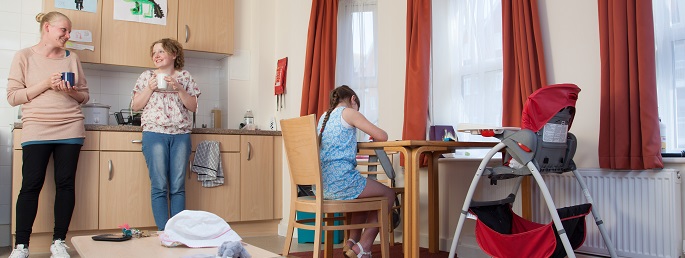
Given that the discussion in the permissions hearing was dealing in hypotheticals, the EHRC had its chance to come up with its best worked example of how this case-by-case approach would work. It came up with this:
“For example, suppose a women’s refuge has a general policy that it will provide services to transwomen, but will not allow transwomen (including those with a GRC) to stay overnight in the refuge because of concerns about the impact on other service users. As the COP makes clear service-providers can have such policies in this area. However, if a transwoman comes in the middle of the night with young children fleeing from a violent male partner (and, for example, she is known to the staff and there are no safety concerns about her, or it may be the refuge is empty that night), it is the EHRC’s view that the refuge should at least consider whether it is appropriate to refuse to allow her and her children to stay the night.”
EHRC Summary Response (Paragraph 38)
This case example is absurdly unrealistic, and treats women and children at their most vulnerable as mere accessories.
In practice, women’s refuges maintain a female-only space 24 hours a day. While some organisations that run women’s refuges also provide services for male survivors of domestic or sexual violence, they don’t do so in the same building where women and children are living. The “female only” rule is not a night-time restriction. The reason is because trauma from male violence does not keep limited hours. Neither does the risk to the security of the service from flexing the rule.
Staff we have spoken to who run female-only services say that on the very rare occasions they receive calls from trans identifying males in distress they will seek to find a facility that will accommodate them, including on occasions sorting out a taxi to pick them up and take them there, or to Accident and Emergency, or to a friend’s home. They deal with the problem in a suitable, humane way, while maintaining their female-only facility. Similarly, if a gay man or unaccompanied underage child contacts them in distress they do not ignore those people in crisis, but do their best to help them find suitable support even though they cannot accommodate them.
The addition of a “transwoman’s young children” to the EHRC’s scenario gives the fleeting impression of someone who is fundamentally similar to the female users of the service. But of course transwomen are males. The only way they can have biological children is by fathering them. In the EHRC’s scenario, the transwoman is known to the service and living with a violent male partner. Either the young children are adopted, and thus already known to social services (who would have recently assessed the family to make the placement) or they have a mother somewhere who has been written out of this picture by the EHRC’s use of gender-identity language. If the situation of these children, living with a violent male to whom they are not related in a home made up of two males (neither of whom may be their father) is already known to this service, it would have already made a safeguarding referral. The need to make snap middle-of-the-night decisions about accommodation in a female-only service to protect the children is entirely concocted. In real life (unless everyone concerned with safeguarding has been ignoring the risk because they have been confounded by gender-identity language), a child protection plan would already be in place.
And what of consulting the other residents of the refuge, or considering the impact on them? Conveniently, the EHRC says the refuge is empty that night.
Women’s Aid, in its most recent audit, says the number of refuge spaces falls short by 30% of the number of spaces recommended by the Council of Europe.
57% of all the referrals received in refuge services in the past year were rejected, with the main reason being lack of space or capacity.
Women’s Aid
The best example of “case by case assessment“ that the EHRC can come up with, from a blank sheet of infinite possibilities, is unrealistic to the point of being insulting. That it works only when the communal service is imagined to be deserted should give it pause for thought.
Even the judge remarked: “This may not be a good case; I don’t know.”
The EHRC’s response to AEA’s case was: “don’t sue us, sue them.” It pushed the responsibility down to individual service providers to defend clear single-sex policies, but left them without official back-up in doing so.
Second-tier organisations, and industry bodies in turn, offer little support to their members, echoing the EHRC’s “case-by-case” recommendation.
Decisions are pushed down to the trustees and local managers of local women’s organisations, and commercial businesses, many of whom are petrified of being branded as “TERFS” and losing their jobs or their funding.
Decisions are then pushed down again to duty staff of individual services (whether a gym, youth hostel, pub or women’s refuge) to make ad-hoc decisions face-to-face. The result is easy to predict: the most vulnerable women, those least able to say no, are pushed around, bullied and humiliated.
What can service providers do?
To protect themselves against lawsuits, and protect their customers and service users (of both sexes, trans and not trans) from humiliation, harassment and hostility, service providers and employers need to be able to have clear policies and rules, which they can communicate and train their staff on.
The Equality and Human Rights Commission (EHRC) says where organisations have issued guidance saying trans-persons must be allowed to access the single sex services of their “acquired gender”, that is directly inconsistent with its advice. It says it has taken steps to bring that to the attention of service-providers who are using erroneous guidance that does not take account of the needs of, or detriment to, others.
But the EHRC has failed to produce promised guidance on single and separate-sex services, and for schools, despite working on this for several years. We think this demonstrates that individualised case-by-case assessment is unworkable.
Organisations should continue to demand guidance from the EHRC. Send in policies and realistic scenarios and demand advice.
But they should also make sure they are as confident as they can be about their own policies: write them down, assess them, communicate them, and in the case of separate-sex services provided for men and women, consider whether additional unisex provision is possible. They should check that they have adequate legal insurance in case they are challenged.
We have published guidance for schools and a briefing for policy-makers and we will be developing guidance for employers and for service providers.
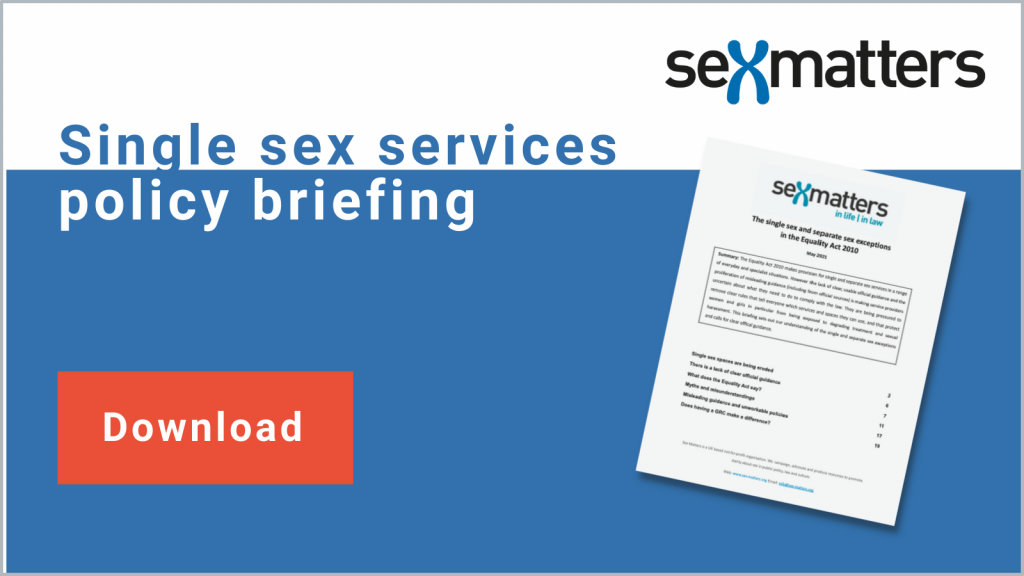
We will consider supporting strategic litigation defending service providers and employers who have established single-sex policies, to defend the provision of single-sex services and facilities, and to challenge the erosion of single and separate-sex services and facilities where they are necessary.
